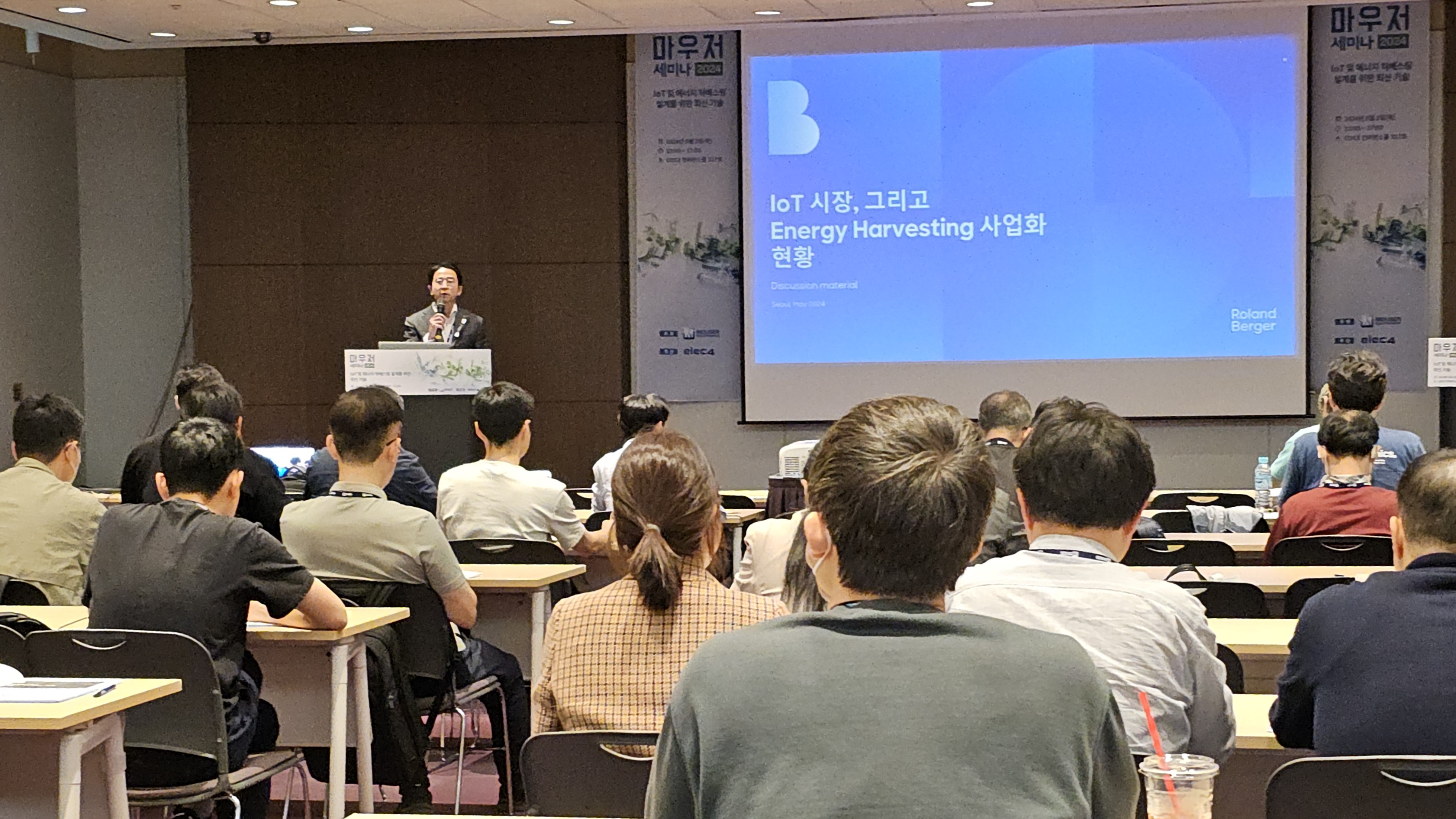IoT 디바이스가 다양한 분야에서 다수 채택됨에 따라 IoT 매개 산업이라고 할 수 있는 에너지 하베스팅 분야가 함께 떠오르고 있다. 재생 에너지 도입 이점과 함께 대체 전원으로 각광받고 있는 에너지 하베스팅 설계가 IoT의 최신 트렌드를 선도하고 있다.

▲마우저 세미나 2024
마우저, 파트너사 함께 IoT·에너지 하베스팅 최신 공유
에너지 하베스팅, IoT 성장세 추월...배터리 수명개선 必
IoT 디바이스가 다양한 분야에서 다수 채택됨에 따라 IoT 매개 산업이라고 할 수 있는 에너지 하베스팅 분야가 함께 떠오르고 있다. 재생 에너지 도입 이점과 함께 대체 전원으로 각광받고 있는 에너지 하베스팅 설계가 IoT의 최신 트렌드를 선도하고 있다.
마우저 세미나 2024가 ‘IoT 및 에너지 하베스팅 설계를 위한 최신 기술’을 주제로 2일 서울 삼성동 코엑스 컨퍼런스룸에서 개최했다.
김광호 롤랜드버거 컨설팅 파트너는 “IoT가 예전부터 존재했지만 최근 성장성에 대한 이니셔티브가 조금씩 발현되고 있는 상황으로 예측한다”면서 “현 시점은 클라우드·엣지 컴퓨팅·통신 기술 발전과 인더스트리 4.0 시대 진입 등으로 인해 수많은 정보를 수집해 사업적인 인사이트로 전환할 수 있는 수익화 트렌드가 가속화되고 있다”고 설명했다.
에너지 하베스팅은 IoT를 큰 수요 시장으로 가진 산업기술로 IoT 성장과 궤를 같이 하고 있다. 김광호 파트너는 “2024년부터 2030년까지 약 20%의 연평균성장률을 에너지 하베스팅에서 기록할 것으로 보인다”며 이는 IoT 시장의 성장세인 13%를 앞서는 수치라고 강조했다.
에너지 하베스팅의 종류에는 기본적으로 광에너지를 전기 에너지로 변환하는 기존 방식이 있으며 이는 과거 계산기 등에서 자주 채택됐다. 이는 모듈이 비교적 단순하고 낮은 비용으로 효율적 설계가 가능하지만 광에너지가 부족한 실내 환경에서는 전원이 부족한 단점이 있다.
또 다른 방식에는 전자기(Electromagnetic) 방식이다. 파장 및 진동을 전자기파로 수집해 전기로 변환한다. 방송 전파, 이동 통신기기 전파, 와이파이 등 버려지는 전자기로부터 에너지를 얻을 수 있어 현대 환경에선 사실상 영구적인 전원을 확보할 수 있다.
열전(Thermal Energy)은 인체 및 기계의 잔열, 폐열 등을 활용해 에너지를 수확하는 방식으로 온도차에 의해 전류가 흐르는 과학적 원리를 이용해 에너지를 생성해낸다. 높은 내구성을 보유하고 있는 것이 특징이다.
압전(Kinetic Energy)은 진동 및 압력에 의해 에너지를 수확할 수 있는 압전 소자를 활용한다. 일상생활에서 발생하는 진동, 충격 등으로 전기적 에너지를 변환할 수 있으며 기계의 진동, 도로 및 계단 등에서 에너지 수확이 가능하다. 높은 에너지 출력 효율과 인풋-아웃풋 전환에 대한 가시성이 높은 것이 특징이다.
주요 플레이어로는 △광전(EXEGER, ST, ADI, EnOcean, 마이크로칩, e-peas, ONiO 등) △전자기(Powercast, ONiO, e-peas, WePOWER, Qorvo 등) △열전(ABB 그룹, EnOcean, ST, e-peas 등) △압전(Piezo.com, EnOcean, e-peas 등)에서 제품을 공급하고 있다.
김광호 파트너는 “아직은 에너지 하베스팅 시장 규모가 성장단계로 굉장히 크다고 말하기는 어렵지만 기술 장벽 및 시장 점유에 의한 장벽이 높지 않은” 상태라고 평가하면서 비즈니스가 파편화돼 있고 경쟁 플레이어들이 적은 시장의 모습을 보인다고 언급했다.
더불어 농산업과 연계한 IoT 센서의 에너지원, 스마트 시티 등 유동인구가 밀집한 공간에서의 IoT 센서·스위치에 대한 에너지원 공급 등 마이크로 솔루션을 타겟하는 실수요형 에너지 하베스팅 솔루션들이 시장을 공략하고 있다고 소개했다.
이러한 에너지 하베스팅은 IoT의 배터리 문제 또한 해결할 수 있는 기술로 소개된다. 이경보 실리콘랩스 이사는 ‘무배터리 IoT를 위한 에너지 효율적인 무선 SoC’를 주제로 발표하며 배터리가 IoT의 성장을 늦추고 있다고 말했다.
모든 배터리는 결국 교체되어야 하며 배터리 수명을 개선하는 방법에는 충전식 또는 배터리 없는 설계만이 해답임을 제시했다. 무배터리 IoT 아키텍처는 △에너지 하베스팅부 △전원 관리 IC △충전식 및 백업 배터리 혹은 대체 배터리 기술 △센서 △IoT 라디오 및 MCU로 구성된다.
배터리 충전용 혹은 배터리 없는 설계를 위해 에너지 하베스팅 소자가 탑재되는데 실리콘랩스는 일정한 에너지 공급이 필요하거나 충전식 애플리케이션용에 쓰이는 에너지원으로 △광전 △진동 및 압전 △전자기파 △열전 등이 활용하며, 자주 딥 슬립 또는 전원 끄기를 하는 도어락, 스마트 버튼 등의 애플리케이션용으로 압전 및 마찰전기를 에너지원으로 활용할 수 있다고 설명했다.
실리콘랩스는 다양한 배터리 지원하는 저전력의 무선 SoC 제품군을 출시하고 있으며 에너지 하베스팅 관련해 오는 9일 테크톡 웨비나를 개최해 에너지 하베스팅을 위한 새로운 블루투스 SoC를 공개한다고 밝혔다.
